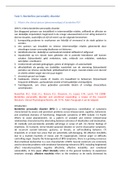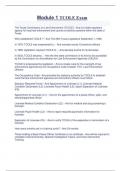Task 5. Borderline personality disorder
1. What is the clinical picture (phenomenology) of borderline PD?
DSM-V criteria borderline personality disorder
Een diepgaand patroon van instabiliteit in intermenselijke relaties, zelfbeeld en affecten en
van duidelijke impulsiviteit, beginnend in de vroege volwassenheid en tot uiting komend in
diverse situaties, zoals blijkt uit vijf (of meer) van de volgende kenmerken:
1. krampachtig proberen te voorkomen om feitelijk of vermeend in de steek gelaten te
worden.
2. een patroon van instabiele en intense intermenselijke relaties gekenmerkt door
wisselingen tussen overmatig idealiseren en kleineren.
3. identiteitsstoornis: duidelijk en aanhoudend instabiel zelfbeeld of zelfgevoel
4. impulsiviteit op ten minste twee gebieden die in potentie betrokkene zelf kunnen
schaden (bijvoorbeeld: geld verkwisten, seks, misbruik van middelen, roekeloos
autorijden, vreetbuien).
5. recidiverende suïcidale gedragingen, gestes of dreigingen, of automutilatie
6. affectlabiliteit als gevolg van duidelijke reactiviteit van de stemming (bijvoorbeeld
periodes van intense somberheid, prikkelbaarheid of angst, meestal enkele uren durend
en slechts zelden langer dan een paar dagen)
7. chronisch gevoel van leegte
8. inadequate, intense woede of moeite om kwaadheid te beheersen (bijvoorbeeld
frequente driftbuien, aanhoudende woede of herhaaldelijke vechtpartijen).
9. Voorbijgaande, aan stress gebonden paranoïde ideeën of ernstige dissociatieve
verschijnselen
Rosenthal, M.Z., Gratz, K.L., Kosson, D.S., Cheavens, J.S., Lejuez, C.W., Lynch, T.R. (2008).
Borderline personality disorder and emotional responding: a review of the research
literature. Clinical Psychological Review, 28, 75-91. Note: Paragraph 6 can be skipped.
Introduction
Borderline personality disorder (BPD) is a heterogeneous constellation of symptoms
characterized by severe and persistent problems across interpersonal, cognitive, behavioral,
and emotional domains of functioning. Diagnostic symptoms of BPD include: (1) frantic
efforts to avoid abandonment, (2) a pattern of unstable and intense interpersonal
relationships characterized by alternating between extremes of idealization and devaluation,
(3) markedly and persistently unstable self-image or sense of self, (4) chronic feelings of
emptiness, (5) transient, stress-related paranoid ideation or severe dissociative symptoms,
(6) recurrent suicidal behavior, gestures, or threats, or self-mutilating behavior, (7)
impulsivity in at least two areas that are potentially self-damaging, (8) affective instability
due to a marked reactivity of mood, and (9) inappropriate, intense anger or difficulty
controlling anger. Despite the heterogeneity of BPD symptoms, there is a growing consensus
that emotional dysfunction is a core characteristic of BPD. Several constructs are commonly
used to describe problems with emotional functioning relevant to BPD, including heightened
affect intensity/reactivity, negative affectivity, affective instability, and emotional
vulnerability. In this paper affect intensity refers to the general tendency to experience
emotions strongly, affective reactivity refers to the tendency to be easily distressed by
,discrete emotional events, and negative affectivity broadly refers to the combination of
negative affect intensity/reactivity and the general tendency to experience negative
emotions. In contrast, affective instability refers to the tendency to experience extreme
fluctuations in affective states (e.g., shifting from intense sadness to anxiety). Emotional
vulnerability in BPD has been defined as the tendency to respond to environmental stimuli
with a heightened sensitivity (e.g., quickly), heightened reactivity (e.g., high magnitude of
arousal), and a delayed recovery to baseline emotional arousal. There are similarities and
important differences between these and other related constructs.
2. What is the empirical evidence for the relation between emotional responding and
Borderline PD? What might be potential explanations for discrepancies, and what are
issues that need to be considered when conducting studies on emotional responding in
Borderline PD?
Rosenthal, M.Z., Gratz, K.L., Kosson, D.S., Cheavens, J.S., Lejuez, C.W., Lynch, T.R. (2008).
Borderline personality disorder and emotional responding: a review of the research
literature. Clinical Psychological Review, 28, 75-91. Note: Paragraph 6 can be skipped.
Note: Read for a summary on the neuroimaging studies Krauze-Utz et al. (2014).
Abstract
Although problems with emotional functioning are considered central to borderline
personality disorder (BPD), it is only recently that studies have begun utilizing laboratory
biobehavioral measures (including neuroimaging and psychophysiological measures) to
examine emotional responding in BPD. The application of basic science methodologies used
in a systematic program of research to investigate clinically relevant phenomena, often
called translational research, holds much promise in advancing the assessment and
treatment of BPD.
Introduction
Borderline personality disorder (BPD) is a heterogeneous constellation of symptoms
characterized by severe and persistent problems across interpersonal, cognitive, behavioral,
and emotional domains of functioning. Diagnostic symptoms of BPD include: (1) frantic
efforts to avoid abandonment, (2) a pattern of unstable and intense interpersonal
relationships characterized by alternating between extremes of idealization and devaluation,
(3) markedly and persistently unstable self-image or sense of self, (4) chronic feelings of
emptiness, (5) transient, stress-related paranoid ideation or severe dissociative symptoms,
(6) recurrent suicidal behavior, gestures, or threats, or self-mutilating behavior, (7)
impulsivity in at least two areas that are potentially self-damaging, (8) affective instability
due to a marked reactivity of mood, and (9) inappropriate, intense anger or difficulty
controlling anger. Despite the heterogeneity of BPD symptoms, there is a growing consensus
that emotional dysfunction is a core characteristic of BPD. Several constructs are commonly
used to describe problems with emotional functioning relevant to BPD, including heightened
affect intensity/reactivity, negative affectivity, affective instability, and emotional
vulnerability. In this paper affect intensity refers to the general tendency to experience
emotions strongly, affective reactivity refers to the tendency to be easily distressed by
discrete emotional events, and negative affectivity broadly refers to the combination of
negative affect intensity/reactivity and the general tendency to experience negative
,emotions. In contrast, affective instability refers to the tendency to experience extreme
fluctuations in affective states (e.g., shifting from intense sadness to anxiety). Emotional
vulnerability in BPD has been defined as the tendency to respond to environmental stimuli
with a heightened sensitivity (e.g., quickly), heightened reactivity (e.g., high magnitude of
arousal), and a delayed recovery to baseline emotional arousal. There are similarities and
important differences between these and other related constructs. In this paper, we refer to
these phenomena as problems with emotional responding.
The goal of this paper is to promote an approach to assessment that advances the
scientific understanding of emotional responding in BPD by not exclusively relying on self-
report measurement. Lastly, problems commonly encountered when conducting
translational research on emotional responding in BPD are outlined, and potential solutions
to these problems are offered.
Self-report studies
One approach to assessing emotional responding is the use of self-report measures, asking
respondents how they experience and/or express emotions. Results of these studies suggest
that individuals with BPD report greater lability in anger and anxiety compared to individuals
with other personality disorders and with bipolar II disorder. Moreover, although individuals
with BPD reported greater depression-anxiety oscillation than individuals with other
personality disorders, they did not report greater depression-anxiety oscillation than
individuals with bipolar II. Instead, greater depression-anxiety oscillation was reported by
individuals with both BPD and bipolar II, compared to individuals with either disorder alone.
Other researchers have utilized field-based approaches to assess affective instability
outside the laboratory. Individuals with BPD reported greater variability in mood from
morning to evening, and less consistency in mood from one day to the next, compared to
individuals with major depression and those without psychiatric disorders. In another study,
individuals with BPD reported greater negative affect and more fluctuations in negative
affect than the other groups. These findings provide supporting evidence for findings of
heightened affective instability in BPD, as well as preliminary evidence for the specificity of
certain forms of affective instability to BPD.
In addition to affective instability, other aspects of emotional responding have been
investigated using self-report methods. These studies indicate that individuals with BPD
report higher affect intensity/reactivity than individuals with other personality disorders or
bipolar II disorder. Interestingly, however, a study suggests that the heightened affect
intensity/reactivity reported by individuals with BPD may be specific to negative emotions.
These researchers found that individuals with BPD reported higher levels of negative affect
intensity/reactivity but similar levels of positive affect intensity/reactivity, compared to
individuals without BPD. Consistent with these findings, recent studies have found that self-
reported negative affect intensity/reactivity is positively correlated with BPD traits/features
and diagnostic symptoms, and is a stronger predictor of BPD symptoms than a history of
childhood sexual abuse.
Finally, some studies have utilized experimental designs that allow for repeated
measurement of negative affect over time. These studies provide evidence that changes in
self-reported BPD symptoms are associated with corresponding changes in negative
affectivity over time. In addition, a recent study utilizing an ecological momentary
assessment approach found that individuals with BPD reported more frequent and higher
levels of “aversive internal tension” that increased more quickly and lasted for a longer
, period of time than in healthy controls. Although BPD is associated with high negative
affectivity, the paucity of direct comparisons between BPD and other diagnostic groups
hinders conclusions regarding the specificity of negative affectivity to BPD. Although the
broad construct of negative affectivity is not unique to BPD, the previously reviewed
research suggests the possibility that problems with particular aspects of emotional
functioning may be more elevated in BPD (e.g., affective instability, negative affectivity) than
in other Axis I and Axis II disorders.
Self-report measures of emotional responding provide a useful method for assessing the
subjective component of emotional responses and have the advantage of being relatively
easy to administer across a wide variety of contexts. However, their utility has several
limitations. First, although emotional responses are made up of several distinct components,
self-report methods assess only the subjective experience component. Second, responses on
self-report measures of emotional responding may be influenced by an individual's
willingness and/or ability to accurately describe subjective experiences. Evidence suggests
that individuals with BPD exhibit deficits in emotional awareness and clarity, potentially
limiting their ability to accurately describe emotional responses. Moreover, responses to
self-report measures of emotional responding may be biased when a respondent
deliberately attempts to constrain emotional experience and/or expression. Recent evidence
indicates that both BPD diagnosis and BPD symptom severity are associated with a
heightened tendency to avoid unwanted internal experiences. Thus, reliance on self-report
measures of emotional functioning may be especially problematic for BPD research.
Translational research: an overview
Translational research involves a systematic attempt to integrate the distinct perspectives of
basic and clinical researchers. Whereas basic research often utilizes well-controlled
laboratory methods to elucidate underlying processes, clinical research focuses on the more
immediate, real-world implications of research findings and emphasizes the importance of
ecological and external validity. The term translational research may be interpreted as
suggesting that the focus of this approach lies simply in the translation of basic findings into
clinical applications. Although basic research has at times produced significant clinical
advances, it is more often the case that basic and applied clinical research operate in
isolation from one another, with their approaches and associated language differing to such
an extent that translation from one to the other is rarely feasible.
A translational research approach includes the use of laboratory methods for assessing
basic processes relevant to specified clinical phenomena. As a program of research begins to
produce a better understanding of basic processes, the focus on clinical applications
becomes more evident, including an increased focus on ecological and external validity.
Translational research on emotional responding in BPD
Recent advances in laboratory technologies offer BPD researchers new opportunities to
directly test hypotheses about emotional functioning using specific biobehavioral measures.
Studies were selected for review if the primary aim of the study was to examine emotional
responding in BPD and participants met full diagnostic criteria for BPD. Furthermore, studies
designed to address related but conceptually different processes in BPD, such as cognitive
processing and appraisal of emotion-related stimuli, pain responsivity, impulsivity, and
executive functioning were excluded.





